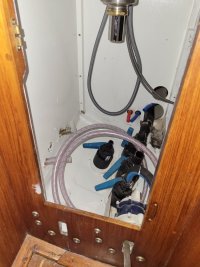Frank Langer
1984 Ericson 30+, Nanaimo, BC
Hi,
I discovered that the bronze raw water intake thru hull is degrading badly, and will replace it, along with six other thru hulls as they are all about 20 years old. I'm guessing that the raw water thru hull is worst due to the faster sea water flow compared with the other thru hulls, but I'm not sure.
I'm leaning to replacing them all with bronze, but am wondering if anyone thinks marelon would be a better choice, especially for the raw water thru hull to avoid the deterioration I'm seeing now.
Any and all thoughts are welcome, as well as any advice on tips to replace thru hulls.
Thanks,
Frank
I discovered that the bronze raw water intake thru hull is degrading badly, and will replace it, along with six other thru hulls as they are all about 20 years old. I'm guessing that the raw water thru hull is worst due to the faster sea water flow compared with the other thru hulls, but I'm not sure.
I'm leaning to replacing them all with bronze, but am wondering if anyone thinks marelon would be a better choice, especially for the raw water thru hull to avoid the deterioration I'm seeing now.
Any and all thoughts are welcome, as well as any advice on tips to replace thru hulls.
Thanks,
Frank

